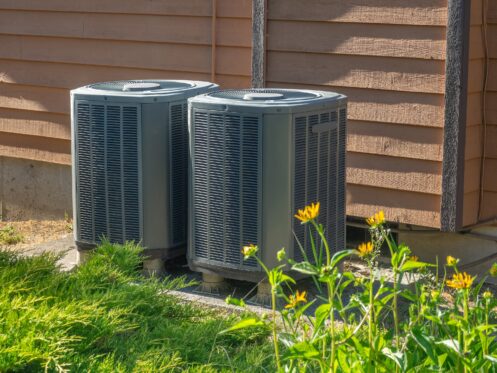A puddle near your AC isn’t something to ignore. Whether it’s dripping slowly or pooling fast, a leak usually means your system is dealing with more than normal. Maybe it’s a clogged drain line, or maybe there’s a crack where moisture shouldn’t be. Either way, it’s your signal to act before small water issues become costly problems. At Blue Best Plumbing, Heating, Air, & Generators, in Bountiful, UT, we help homeowners spot the signs early and get things fixed fast.
Why Your AC Leaks
Your air conditioner doesn’t use water, but it does pull moisture out of the air. That humidity needs a place to go. Normally, it condenses into water and flows down a drain line. When that line gets blocked or disconnected, the water has no exit. It begins to collect inside the unit, usually around the evaporator coil or the drain pan.
Once that pan fills, the water finds another way out, usually down the wall or onto the floor. A clogged line might be filled with dust or algae. A loose connection might just need tightening. Either way, if you see pooling water, it means your unit can’t drain the way it’s supposed to. Of course, the leak won’t fix itself.
Difference Between Condensation and a Problem
Some moisture is normal when your AC runs on humid days. But there’s a fine line between safe operation and a mess in the making. You might notice some beads of water on the copper line near the indoor unit or a small damp spot near the drain pipe. That’s not usually a cause for alarm.
What’s not normal is a steady drip, a soaked air filter, or water spilling out near the bottom of the unit. If your system sounds like it’s bubbling or sloshing during operation, that’s often a sign that water isn’t moving the way it should. Some leaks look worse than they are, but others start small and lead to mold, rust, or water damage that spreads behind walls.
Why Your Drain Line Matters More Than You Think
The drain line is a narrow pipe, often made of PVC, that carries water from your AC system to a safe discharge point. When this pipe gets clogged, water can’t escape. Instead, it backs up into the unit. You might see green slime or debris if the clog is bad, or you’ll see nothing at all if the block is deep inside the pipe. Either way, the water starts to rise, spilling over the edge of the pan.
The line itself is easy to overlook because it usually runs out of sight, behind the unit or into the wall. But that hidden pipe plays a major role in keeping your system dry and damage-free. You can try flushing the line with vinegar if you know where the access point is, but sometimes it takes an AC repair pro to clean it out without causing more trouble.
How a Damaged Drain Pain Triggers Leaks
Every central AC has a pan beneath the evaporator coil that catches the water pulled from the air. This pan is designed to hold water briefly before it moves into the drain line. But over time, these pans can rust, crack, or shift out of position. If that happens, water collects in a way that it shouldn’t.
A small crack can leak slowly for weeks before you notice. Some older units have metal pans that corrode, while others use plastic that becomes brittle with age. A leak from the corner of the pan or a damp ceiling below the attic unit often points to this kind of issue. It’s usually not something you can patch with tape or glue. Replacing the pan or leveling it back into position is the safer bet if you want to stop the problem for good.
Role of a Clogged Air Filter in AC Leaks
It might not seem obvious, but a dirty air filter can set off a chain reaction that ends in a leak. When airflow drops, your evaporator coil can get too cold and freeze. That frost eventually melts, which can overwhelm the drain pan. A soaked filter can also let water drip onto other parts of the unit. Changing your filter regularly keeps the air moving the way it’s supposed to and helps stop moisture from freezing in the first place.
What Refrigerant Issues Have to Do With Moisture
Leaks caused by refrigerant problems aren’t water-based, but they can lead to the same symptoms. When your refrigerant levels drop, your coil doesn’t stay at the right temperature. This imbalance makes it more likely to freeze, which means you get frost buildup followed by melting water that overruns your pan.
You might notice the system running longer, the air not feeling cold, or ice forming around the indoor unit. These are subtle signs that something isn’t right. Low refrigerant also forces your system to work harder, which can accelerate wear on the rest of the unit.
Why Timing Matters With HVAC Leaks
A small leak on a hot day can turn into a much bigger mess overnight. That’s because your AC doesn’t just run now and then during peak summer. It cycles often, which means any problem with water drainage gets worse fast. Carpets can soak through, ceilings can stain, and drywall can swell or collapse if the leak goes unnoticed. Mold starts quickly in warm, damp places. You don’t always get a warning before the damage sets in.
That’s why early checks matter. If your system has leaked before or if you’ve noticed moisture building up in the same spot more than once, that pattern should prompt a closer look.
Staying Ahead of the Next Leak
Once your AC has leaked, it’s easier to keep a close eye on it. You know what to look for. You know what areas tend to collect moisture or start dripping first. Preventative checks matter more than you think. If your system gets regular maintenance, these kinds of leaks can often be avoided entirely.
Technicians catch worn parts, blocked lines, and rusted pans before they fail. If you’ve already had to clean up water or deal with warped drywall, it’s worth being proactive next time. Keep the filter fresh. Watch for signs of ice. Check your drain line after storms or heat waves. Small habits will help prevent the next problem.
When DIY Meets Its Limits
You can check your filter. You can look for water around the unit. You might even be able to flush the drain line if you know what you’re doing. But most of the time, if you’re dealing with repeated leaks, strange smells, or visible damage, it’s time to step back. AC units are complicated systems with wiring, refrigerant, and sensitive components. Fixing one part without understanding the rest can make things worse.
A water problem might hide behind insulation or inside ductwork. If you’ve done what you can and the leak keeps coming back, don’t wait until the damage spreads. Knowing when to stop poking around and get help can save you from higher costs and bigger headaches.
Protect Your AC Unit Now
A leaking air conditioner doesn’t have to ruin your summer. Catching the signs early can save your floors, your ceiling, and your energy bill. Whether it’s a quick fix or a sign of something bigger, you deserve answers and options that make sense. To get started with an expert assessment, schedule cooling services with Blue Best Plumbing, Heating, Air, & Generators today.
We also offer air conditioner tune-ups, ductless mini-split installations, and smart thermostat setups.








